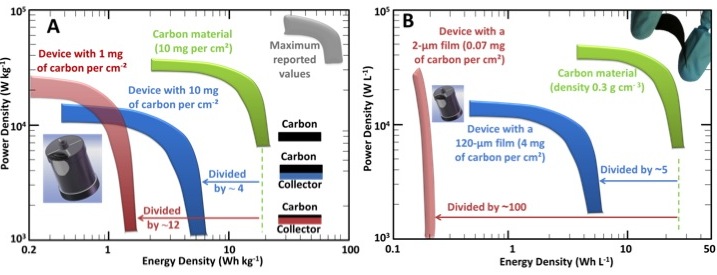True Performance Metrics
in Electrochemical Energy Storage
Y. Gogotsi * and P. Simon **
Exceptional performance claims for electrodes used in batteries and electrochemical capacitors
often fail to hold up when all device components are included.
______________________________________
* Department of Materials Science and Engineering and
A. J. Drexel Nanotechnology Institute, Drexel University,
Philadelphia, PA 19104, USA.
** Université Paul Sabatier–
Toulouse III, CIRIMAT UMR-CNRS 5085, 118 Route de Narbonne,
31062 Toulouse, France. E-mail: gogotsi@drexel.
edu, simon@chimie.ups-tlse.fr
À dramatic expansion of research in the
area of electrochemical energy storage
(EES) during the past decade has
been driven by the demand for EES in handheld
electronic devices, transportation, and
storage of renewable energy for the power
grid . However, the outstanding properties
reported for new electrode materials may
not necessarily be applicable to performance
of electrochemical capacitors (ECs). These
devices, also called supercapacitors or ultracapacitors
, store charge with ions from
solution at charged porous electrodes. Unlike
batteries, which store large amounts of energy
but deliver it slowly, ECs can deliver energy
faster (develop high power), but only for a
short time. However, recent work has claimed
energy densities for ECs approaching or
even exceeding that of batteries. Prof. Y. Gogotsi and Prof. P. Simon in that paper, published in Science Magazine, show
that even when some metrics seem to support
these claims, actual device performance
may be rather mediocre.They focused in that paper on ECs, but these considerations also apply to lithium (Li)—ion batteries.
Increasing the energy density of ECs usually
comes at the cost of losses in cyclability or power, which are the most important
properties of ECs and without which they
become mediocre batteries. A major effort has
been directed toward increasing the energy
density of ECs by either increasing the capacitance
of the material, or the operation
voltage window, or both.
Some recent
publications on graphene and nanotube-based
materials have used Ragone plots to argue that
supercapacitors can achieve the energy density
of batteries.
Reporting the energy and power densities
per weight of active material alone on a
Ragone plot may not give a realistic
picture of the performance that the assembled
device could reach because the weight of
the other device components also needs to be
taken into account. ECs are similar to Li-ion
batteries .

A tale of two plots. One way to compare electrical energy storage devices is to use Ragone plots ( 10), which show both power
density (speed of charge and discharge) and energy density (storage capacity). These plots for the same electrochemical capacitors
are on a gravimetric (per weight) basis in (A) and on a volumetric basis in (B). The plots show that excellent properties of
carbon materials will not translate to medium- and large-scale devices if thin-fi lm and/or low-density electrodes are used ( 10).
By presenting energy and power densities
in a consistent manner, researchers can facilitate introduction
of new materials and fi nd solutions
for EES challenges the world faces. National
and international testing facilities should be
created for benchmarking electrodes and
devices similar to the facilities that exist for
benchmarking photovoltaics. Clear rules for
reporting the performance of new materials
for EES devices would help scientists who are
not experts in the fi eld, as well as engineers,
investors, and the general public, who rely on
the data published by the scientists, to assess
competing claims. But numerous scientists who
have been publishing ridiculous claims about enormous capacity of novel
battery materials and energy density of electrochemical capacitors exceeding
that of Li-ion batteries in the past couple of years will not like this discourse.
Source: science.mag.org